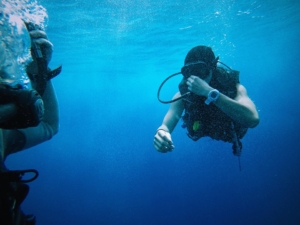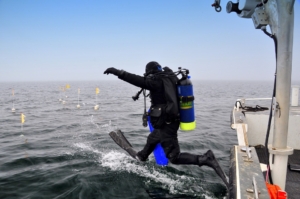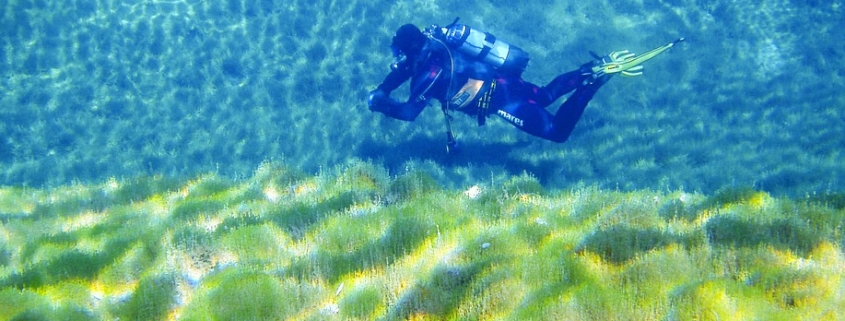When most people think of common scuba diving locations, they immediately envision saltwater environments. However, it’s perfectly fine to dive in freshwater environments. Some divers, in fact, prefer freshwater environments over saltwater environments. But if you’re thinking about making the transition to freshwater, there are a few things you need to know.
The Advantages of Freshwater Diving

Freshwater diving offers several advantages, one of which is the chance to see entirely new aquatic ecosystems. In terms of ecosystems, the difference between freshwater diving and saltwater diving is light night and day. Saltwater environments tend to have a larger variety of animals and plants, whereas freshwater environments have fewer and more specific animals and plants. As a result, diving in freshwater allows you to explore new ecosystems that aren’t possible with saltwater diving.
Depending on where you live, diving in freshwater may be more convenient than diving in saltwater. If you live in the Central United States, for example, it may take a full day of driving to reach a beach. If there’s a lake nearby, on the other hand, you won’t have to waste your time and gas driving.
Riptides are also less likely to occur in freshwater than in saltwater. When diving in an ocean, you may get swept away by a riptide. While riptides can occur in freshwater, they are much less common than in saltwater.
The Disadvantages of Freshwater Diving
On the other hand, there are a few disadvantages of freshwater diving. You may discover, for instance, that freshwater environments are colder than saltwater environments. Even if the actual outdoor temperature is the same, a body of freshwater will probably feel cooler than a body of saltwater. As a result, some divers may experience discomfort when diving in freshwater, especially if they aren’t prepared with the appropriate equipment (see below).
Certain freshwater diving environments can also have poor visibility. As sediment, dirt and debris float through the water, it can restrict your ability to see. Using a high-quality diving mask can help, but you still won’t be able to see as far or as clearly as you would when diving in saltwater.
As previously mentioned, there’s also less diversity regarding the ecosystems of freshwater environments. If you’re looking to encounter a wide variety of aquatic animals, as well as plants, you may want to stick with traditional saltwater diving. The high concentration of particulate matter in freshwater restricts visibility when diving.
Choosing the Right Freshwater Diving Location
If you’re going to dive in freshwater, you need to choose the right location. Rivers are typically a poor choice because of their shallow depths and fast-moving currents. Instead of choosing a river, consider diving in a large lake or pond.
On its website, the Professional Association of Diving Instructors (PADI) lists several of the world’s top locations for freshwater diving. On its list, PADI recommends the ponds and sinkholes surrounding Mount Gambier in Australia. Featuring natural limestone and crystal-clear waters, it’s a truly amazing environment for freshwater diving. Another freshwater diving location recommended by PADI is Playa Del Carmen in Mexico. It’s a relatively shallow cavern — about 20 feet at its deepest point — that features natural stalagmites. Because of this, you’ll need to PADI Cavern Diver certification to dive at Playa Del Carmen. These are just a few of the world’s top freshwater diving locations. You can click on the aforementioned link for more freshwater diving locations recommended by PADI.
Regardless of which body of freshwater you intend to dive in, do your research before making the trip. A quick online search of the location’s name followed by “diving” should reveal stories from past divers. You can then decide whether it’s a suitable location for diving. If you discover a lot of positive comments from previous divers, it’s safe to assume the location is a good choice for your first freshwater dive. If most of the comments are negative, however, you may want to search for a different freshwater diving location.
Preparing Your Equipment for Freshwater Diving
 You’ll need to prepare all the necessary equipment for freshwater equipment. The good news is that freshwater diving — for the most part — requires all the same basic equipment as saltwater diving. This includes a diving mask, also known as a scuba mask, as well as fins, a diving suit, a breathing apparatus and a buoyancy control device (BCD). Check out this previous post for more information on what equipment you’ll need.
You’ll need to prepare all the necessary equipment for freshwater equipment. The good news is that freshwater diving — for the most part — requires all the same basic equipment as saltwater diving. This includes a diving mask, also known as a scuba mask, as well as fins, a diving suit, a breathing apparatus and a buoyancy control device (BCD). Check out this previous post for more information on what equipment you’ll need.
With that said, you may want to bring other equipment when diving in freshwater. A waterproof camera, for example, will allow you to capture photos of your underwater adventure, whereas a waterproof dive watch will allow you to easily keep track of the time. Feel free to bring other items when diving in freshwater, but don’t forget to bring the aforementioned essentials.
Freshwater Diving Safety 101: What You Need to Know
While riptides are less common in freshwater, injury can still occur if you don’t take the appropriate safety precautions when diving. However, that shouldn’t stop you from advancing your diving skills into freshwater environments. By following some basic safety tips, you can safely explore freshwater environments.
Here are some general safety tips to follow when diving in freshwater:
- Invest a high-quality, adjustable diving mask to improve your underwater visibility.
- Always dive with at least one other person (don’t go solo diving in freshwater).
- Beware of potential hazards hidden on the bottom. From old boats and anchors to fishing lures and fallen trees, there are a variety of potential hazards lurking at the bottom of freshwater environments.
- Plan your freshwater dives during the daylight hours. While diving at night may sound peaceful and serene, you can expect a cooler water temperature as well as lower visibility than daytime diving.
- Inspect and check all your gear before jumping into the water.
- Stay within a reasonable distance from the boat or shore. If you swim too far when diving in freshwater, you may not have the energy to make it back.
- As with saltwater diving, you should follow the rule of thirds when diving in freshwater. This means you should use no more than one-third of your total air supply during the descent and no more than one-third of your total air supply when ascending back to the surface. The remaining one-third of air is a reserve for emergency purposes.
- Because the human body is more buoyant in saltwater, you’ll need to use less weight to achieve neutral buoyancy than you would when diving in saltwater.
Log Your Freshwater Dives
Don’t forget to log your freshwater dives. Some people assume that dive logs should only be used for saltwater dives, but this couldn’t be further from the truth. You should always log your dive, regardless of whether it was a saltwater or freshwater dive.
By logging your freshwater divers, you’ll have a written record of your experience that you can use for future reference purposes. You’ll know exactly how much air you used, how long you stayed underwater, the temperature of the water and more. How does this information benefit you exactly? Well, you can refer to your dive logs when planning future dives in freshwater environments. If you were particularly cold during the dive, for instance, you can wear a thicker diving suit the next time you go diving in similar freshwater conditions.
Want to create your own custom dive logs? Contact us today to learn more about our custom dive logs.



